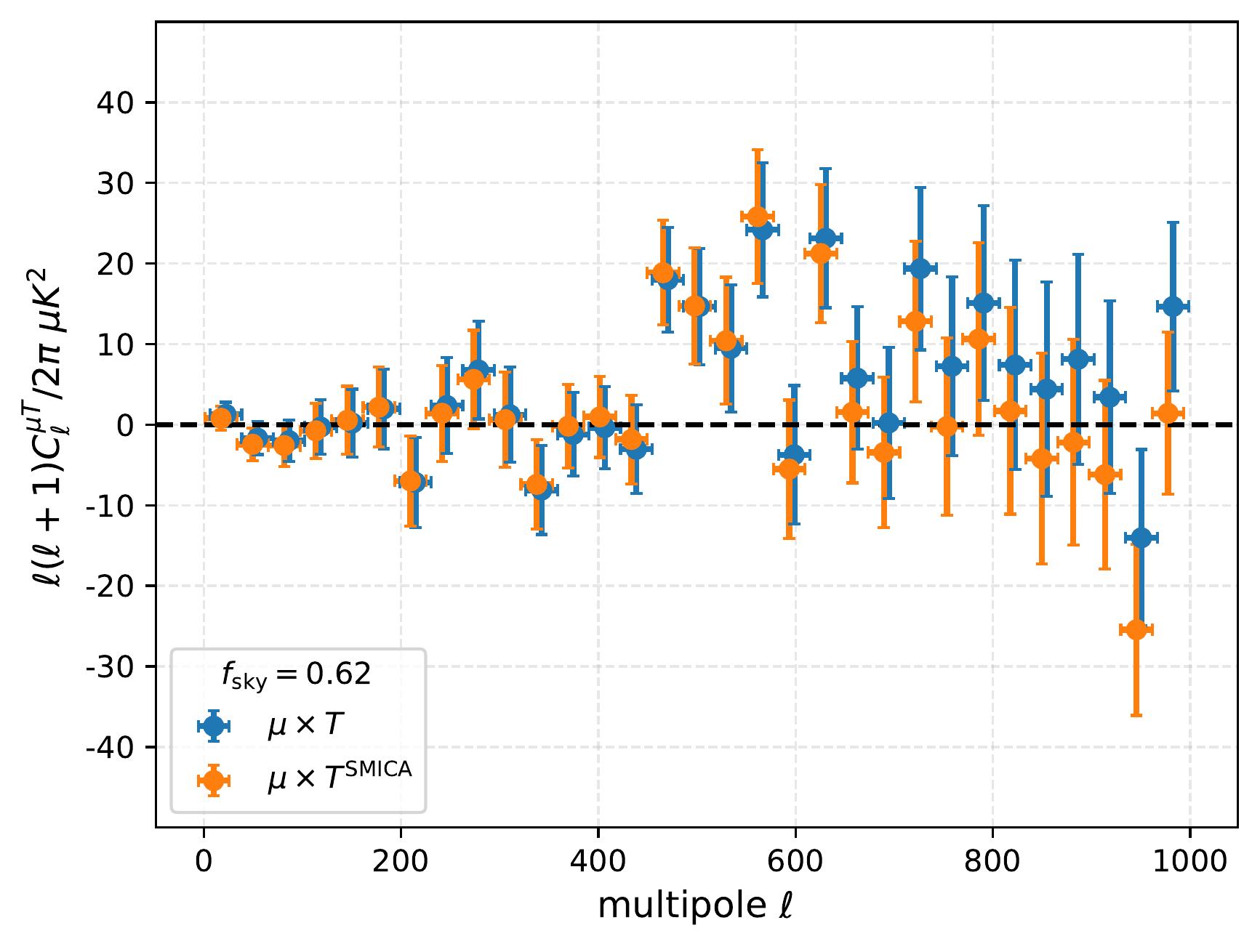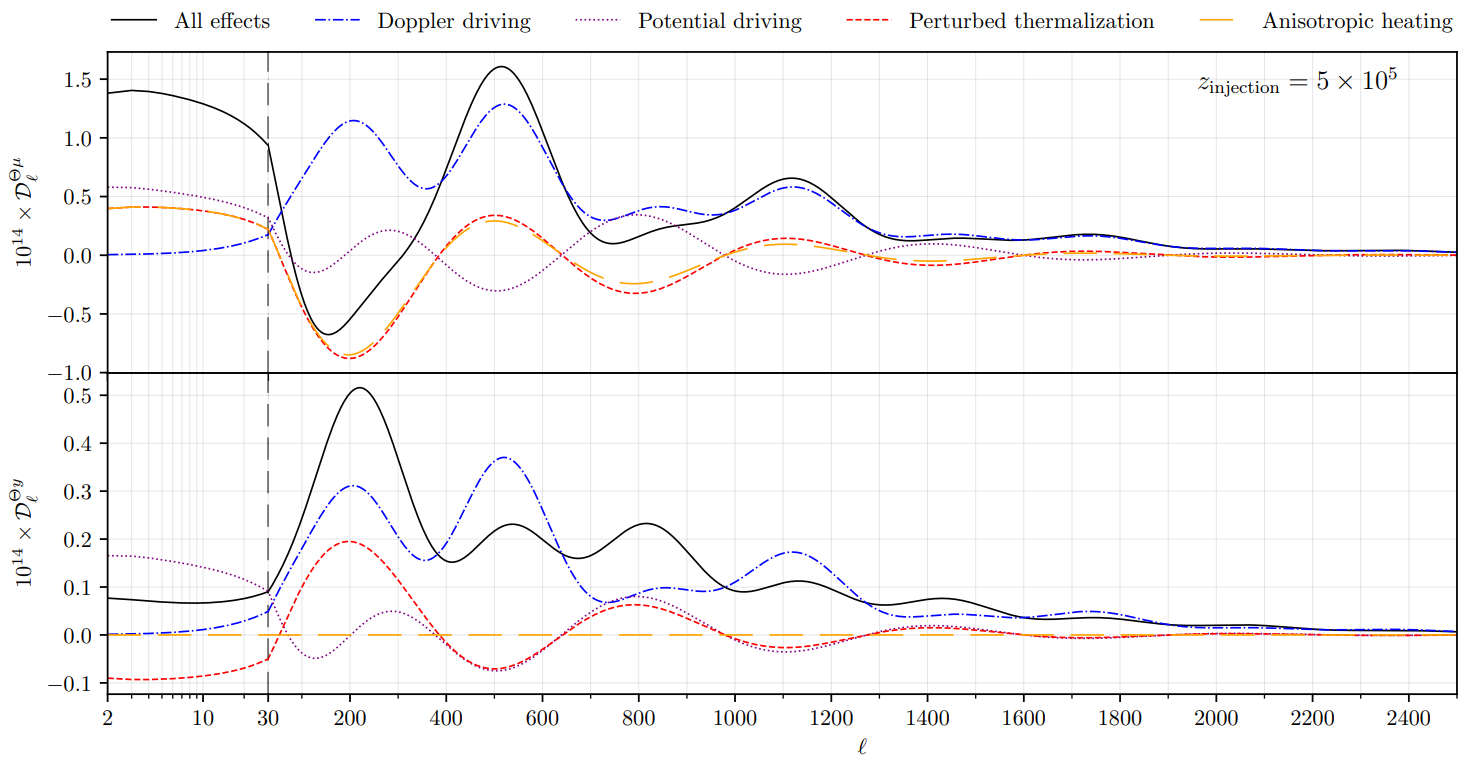
Spectral distortions anisotropies
Constraints on primordial non-Gaussianity
 Primordial non-Gaussianity can source μ-distortion anisotropies that are correlated with the large-scale
temperature and polarization signals of the cosmic microwave background. A measurement of μT and μE
correlations can therefore be used to constrain it on wavelengths of perturbations not directly probed by
the standard CMB anisotropies. We have run thorough forecasts for a variety of state-of-the-art and upcoming
surveys, and developed a pipeline based on needlet constrained internal linear combination which we have
applied to Planck data.
Doing so, we have reconstructed for the first time a temperature-free Planck μ map, and we have set
the first constraints on local non-Gaussianity which use the whole multipole information and polarization
data.
Primordial non-Gaussianity can source μ-distortion anisotropies that are correlated with the large-scale
temperature and polarization signals of the cosmic microwave background. A measurement of μT and μE
correlations can therefore be used to constrain it on wavelengths of perturbations not directly probed by
the standard CMB anisotropies. We have run thorough forecasts for a variety of state-of-the-art and upcoming
surveys, and developed a pipeline based on needlet constrained internal linear combination which we have
applied to Planck data.
Doing so, we have reconstructed for the first time a temperature-free Planck μ map, and we have set
the first constraints on local non-Gaussianity which use the whole multipole information and polarization
data.
References:
AR, M. Liguori, N. Bartolo, and M. Shiraishi, Primordial non-Gaussianity with μ-type and y-type spectral
distortions: exploiting Cosmic Microwave Background polarization and dealing with secondary
sources, JCAP 09 (2017) 042,
[arXiv:1707.04759]
M. Remazeilles, AR, and J. Chluba, Leverage on small-scale primordial non-Gaussianity through
cross-correlations between CMB E-mode and μ-distortion anisotropies, Mon. Not. Roy. Astron. Soc. 512
(2022), no. 1 455–470, [arXiv:2110.14664]
A. Rotti, AR, and J. Chluba, Non-Gaussianity constraints with anisotropic μ distortion measurements from
Planck, Mon. Not. Roy. Astron. Soc. 515 (2022), no. 4 5847–5868, [arXiv:2205.15971]
Evolution of anisotropic spectral distortions

Inhomogeneous spectral distortions of the cosmic microwave background, which arise naturally from
non-homogeneous energy injections, evolve in a perturbed universe obeying a high-dimensional system of
partial differential equation, which stems from the fact that the spectral evolution has to be explicitly
taken into account.
We show that by expanding the photon spectrum in a basis generated by the boost operator the complexity of
the calculation reduces drastically, and the problem can be described by a common hierarchy of Boltzmann
equations. These can be integrated using the procedure commonly adopted to calculate temperature
fluctuation, which enabled us to calculate the spectral distortion angular power spectra. As a case study,
we have forecasted the detectability of instantaneous energy injection and of a decaying particle
scenario.
References:
J. Chluba, T. Kite, and AR, Spectro-spatial evolution of the CMB. Part I. Discretisation
of the thermalisation Green’s function, JCAP 11 (2023) 026, [arXiv:2210.09327]
J. Chluba, AR, and T. Kite, Spectro-spatial evolution of the CMB. Part II. Generalised Boltzmann
hierarchy, JCAP 11 (2023) 027, [arXiv:2210.15308]
T. Kite, AR, and J. Chluba, Spectro-spatial evolution of the CMB. Part III. Transfer functions, power
spectra and Fisher forecasts, JCAP 11 (2023) 028,
[arXiv:2212.02817]